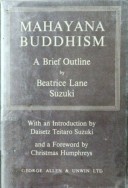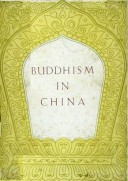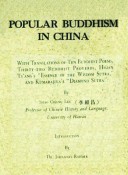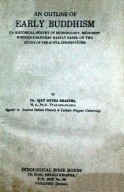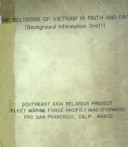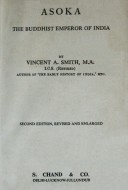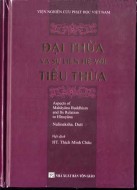Tìm Sách
Sách tiếng Anh-English >> Mahayama Buddhism
Thông tin tra cứu
- Tên sách : Mahayama Buddhism
- Tác giả : Beatrice Lane Suzuki
- Dịch giả :
- Ngôn ngữ : Anh
- Số trang : 146
- Nhà xuất bản : Ruskin House - London
- Năm xuất bản : 1959
- Phân loại : Sách tiếng Anh-English
- MCB : 1210000003860
- OPAC :
- Tóm tắt :
Mahayama Buddhism
with an Introduction by Litt.Dr. Daisatz Teitaro Suzuki
and a Forword by Christmas Humphreys
Forword to second Edition
Of recent years an increasing number of persons living in the West have become interested in Buddhism. Hitherto they have for the most part been provided exclusively with translations from the Pali Canon, which represents the teaching of the Hinayana or Southern School, and text-books based upon that teaching. With the application of the “higher criticism” to the contents of this Canon, however, doubts were raised as to the extent to which it truly represented the Buddha’s teaching. Western scholars began to appreciate that in any event this Canon only represented one-half of the field of Buddhism, and increasing attention was accordingly paid to the teachings of the Mahayana or Northern School. It is true that a cursory examination of such Mahayana Scriptures as were then available in translations from the Sanskrit, Chinese, and Tibetan languages revealed a wide miscellany of doctrine, ranging from the salvation by faith of the Pure Land Sects to the intuitive- intellectual “Sudden Path” of Zen, but deeper study showed a consistent development from the seeds to be found in the Southern School, and a body of doctrine, producing a profoundly different point of view, which was common to all schools of the Mahayana.
To the true scholar the materials for study are always available, for he has the time and the means to study texts in the original. The less favoured student, desirous of seeking in the field of Mahayana for the complementary doctrines to those expounded by the Southern School, looks for a text-book to guide him in his search, and looks for one which is expressed in simple language, is small in’ compass yet fairly comprehensive, and reasonably cheap. No such thing existed in this country.
In the 1930’s, Dr. D. T. Suzuki’s own Outline of Mahayana Buddhism was out of print, while Dr. McGovern’s Introduction to Mahayana Buddhism, besides being out of print, was somewhat technical in form. The Buddhist Society therefore got in touch with Mrs. B. L. Suzuki, the American wife of the Dr. D. T. Suzuki, and she, in the intervals of much other work, kindly compiled this manual to supply the deficiency.
Yet it was not at the time allowed to succeed in its purpose. Within a few months of our receiving the MS from Japan Mrs. Suzuki passed away, and before the published book could be made known in the West the shadow of war had once more fallen. In December, 1940 the whole of the remaining stock of the first edition was destroyed by fire.
Now the shadow of war is partly lifted, and the western hunger for eastern thought revives. But although the works of Dr. Suzuki will shortly be reprinted, and a long list of hitherto untranslated Scriptures are promised from China, there is still no work, in print on Mahayana Buddhism as a whole. When, therefore, David Marlowe Ltd. offered to re-publish this work without delay the Buddhist Society, already committed to a long list of publications, new and old, gladly assented.
In preparing the original work for a new edition I have re-read it in the light of recent experience. In 1938 I received the MS as a description which I could not criticise, but in 1946 I spent sue months in Japan, and can therefore add to Mrs. Suzuki’s account of Japanese Mahayana Buddhism a few words of my own on its present condition. Being widely known in Japan through the Society’s organ, The Middle Way, I was welcomed at all levels of society, by professors and abbots, by village school-masters and artists as well as by the aristocracy. I knew already of a dozen Buddhist schools of thought in Japan, but I was told to my surprise of fifty-two. The differences between many of them were negligible, but those between the two main schools of tariki and jiriki were not to be ignored. In the belief that the peaceful future of Japan depends on a revival of Buddhism, which was the source of its greatest art and culture, I sought for a common’ ground between these schools, and having with me a copy of Twelve Principles of Buddhism, originally drafted by the Society for the use of western enquirers, I used them as an excuse to convene on a common platform representatives of the various sects. Committees were formed in Tokyo and Kyoto, and a Japanese translation agreed. Unimportant differences, largely of ritual or emphasis, were soon discarded, and after a while the formidable barrier of tariki vs. jiriki alone prevented a complete acceptance of these Principles as the common denominator of Japanese Mahayana Buddhism. I mention this, because in the present work Mrs. Suzuki treats the distinction as of minor importance, (pp. 74 and 148), and I found it fundamental. The Buddhism of the Southern School or Thera Vada (Way of the Elders) is strongly jiriki. “Work out your own salvation,” said the Blessed One according to the Pali Canon, “and with diligence.” From this point of view the doctrine of tariki, salvation by some outside Power, is anathema. Where was the bridge on which these two might meet in concord?
The issue reached a critical stage at a meeting in the stronghold of the “Pure Land” Sect, the Nishi Hongwanji Temple in Kyoto. The tariki pundits, in the presence OỈ the hereditary Prince-Abbot himself, implacably disapproved of the phrase in our Principles which stressed “self-salvation” as basic to the Buddhist way of life. I argued that “the ways to the Goal are as many as the lives of men,” and that both tariki and jiriki are in the long run means to an end, ways of “working out one’s own salvation.” In the end it was the Prince-Abbot himself, a brilliant young man with a University degree, who suddenly announced: “I agree with Mr. Humphreys. Tariki and jiriki are both means to self-enlightenment.” And that was that. At a later meeting the seventeen major Schools approved the Principles, which therefore form today, at least in theory, the common basis of Japanese Mahayana Buddhism.
In China I presented the Principles to the late Venerable Tai Hsu, who approved them on behalf of millions of Chinese Buddhists. I have yet to secure the approval of Tibet.
But the approval of leading minds would be academic were it not backed by a spontaneous and profound revival of the power of Buddhism to affect the lives of the people, and provide the motive force for a reawakening of the spiritual life of the countries concerned. In Japan I found signs of this revival everywhere. New lay societies, temple conferences, summer schools, joint committees, new forms of teaching and preaching, and above all new means of bringing the living strength of Buddhist principles into the lives of the people—all were in evidence. Buddhism created the best of the art and culture of Japan, and it is recreating them today, in China the position is more complex. China is a vast country, and with the present bleeding wound of civil war is divided against herself internally. Monastic life seems moribund, partly from a deterioration in the quality of those who enter the Order, and partly because the new life seeping through the veins of an. ancient civilisation is making new forms for its expression. In Japan reform will arise as much in the monastery-temples as in lay associations; in China I look to the Universities to provide new studies in these tremendous principles of Buddhism which will, as in the past, work through into the lives of the people and, wedded to the ingrained culture of Confucius, produce new modes of living for a new society.
Meanwhile the world grows smaller, and East and West must meet on the only bridge where-peace can find a home, new understanding. In the West we need more knowledge of the East, and no one can understand either China or Japan who does not understand the principles of Mahayana Buddhism. Here is a volume in which that understanding will be found.
In Japan I had the privilege of working in my spare time with Dr. D. T. Suzuki who, in the Introduction to this work, has written what amounts to a thesis of his own on the subject. I know that no one will be more delighted than he to learn that his late wife’s final work is once more available.
London, April, 1948.
CONTENTS
Foreword to Second Edition
Preface
Introduction
PART ONE.
Chapter I. Hinayana and Mahayana (The claim of Mahayana; early history; the development of Mahayana; further considerations of Hinayana and Mahayana)
Chapter II. 1. Causation, Karma and Non-Ego
- The Buddhist Doctrine of Knowledge
- Tathata, Nirvana (The Mahayana doctrine of Tathata (Suchness); Sunyata and Prajna; Nirvana)
- Trikaya; The Three Bodies of The Buddha (Nirmanakaya; Sambhogakaya Dharmakaya)
- Amdia
- Bodhisattva
- Enlightenment and Salvation
Chapter III. Further Developments of Mahayana
Chapter IV. Mahayana in Practice (Priests, monks and nuns; laymen services for remembrance of the dead; meditation; religious festivals and special observances)
Chapter V: Outline of’ Some Important Mahayana Sutras (Prajna Paramita; Avatamsaka; The Gandavyuha; Dasabhumika; Vimalakirti Nirdesa; Saddharma Fundarika; Srimaladevi; Brahmajala Sutra Sukhavativyuha ; Mahaparinitvena Sutra; The Lankavatara Sutra Vajrasekhard Sutra; Kishin-ron Sutra)
PART TWO.
Chapter VI. Extracts from Mahayana Sutras (General teaching of the Buddhas; True Nature of All Things; The mind transiency; Buddha-nature; Mind is the origin of sin; Karma; Transmigration; The origin of ignorance; The way of emancipation; Meditations; Modes of wisdom; Buddha-com- passion; The Buddha-body; The Buddha-field; Transmigration is Nirvana; A précept; Faith; Enlightenment; Repentence; A daily Precept; The Root of Desire; Patience; Diligence; Chastity; Gratitude; Master and Friend; The spirit of Charity; How to behave in this life; To take refuge in the three treasures; Preach according to the capacity of Beings The Bodhisattva)
Chapter VII. Conclusion (Persons revered in Japanese Buddhism; Bodhisattva revered in Japanese temples; Buddhist ethics; art; animals in Mahayana; Buddhism; What Mahayana is not; What it means to be a Mahayana Buddhist)
A Selected List of Books
A Short Glossary of Buddhist Terms
Appendix. Twelve Principles of Buddhism
A Selection of Books published since 1948
PREFACE
It is assumed that the reader of this little book is already familiar with the life of the, Buddha and the general ideas of his doctrine as they can be read in the manuals, both scholarly and popular, of Western writers. The life of the Indian prince who gave up his family and home to seek enlightenment, who obtained it under the Bodhi tree, and who then returned to the world to teach the Way to his fellow beings is well known. The doctrine of what is called Primitive Buddhism, but which is really a form of later Hinayana teaching, has also been explained by Western writers, as have the main points of this Buddhism, many of which are found in all forms of Buddhism. These main points are: The Three Marks of Impermanence (anicca), Suffering (dukkha), and Non-Ego (anatta); The Four Noble Truths: (l) The Existence of Suffering, (2) the Cause of Suffering, which is Desire, (3) the End of Suffering, and (4) the Way Out of Suffering, which is the Eightfold Noble Path; The Twelve-linked Chain of Causation; the Law of Cause and Effect, or Karma, and the teaching of perpetual flux, or becoming. This Buddhism holds up the ideal of Arhatship, the necessity for all men to strive after liberation from the wheel of birth and death.
Mahayana accepts many of these doctrines but holds some of them less important. What is most important in Mahayana is Enlightenment, freedom from Illusion, and the aspiration after Buddhahood, and this not only for a few wise monks but for all beings.
As this little book is on Mahayana Buddhism, I refer the reader to the many good books on early Buddhism, and, except for describing some of the chief differences to be found between Mahayana and Hinayana, will confine myself to the more important teachings of Mahayana Buddhism.
I have not in this Primer written anything about the Buddhism of Tibet. Much fine Mahayana teaching is to be found in Tibetan Buddhism, but it is so mixed with non-Buddhist elements that it cannot be called pure Mahayana, which reveals itself in the teachings and documents of India, China, and Japan. Moreover, I am not familiar enough with Tibetan Buddhism to feel myself competent to write of it. In my own study, I have concentrated upon Mahayana as found in India, China, and Japan, and most especially in Japan, where I consider Mahayana Buddhism is living most vitally to-day. Materials for this study are chiefly to be found in books in the Japanese language by Japanese writers, but I have consulted the works of prominent Western and Indian scholars also.
Pali Buddhism was the first to come to the knowledge of European scholars, and therefore of the general public. The books and sutras of Mahayana came to their knowledge later, and Mahayana is therefore not so well understood in the West. Buddhists of the Southern School, and others who are in sympathy with that form of Buddhism, may feel that the development of Mahayana has taken it far away from what they consider the early and true form of Buddhism, and may even say that Mahayana is not Buddhism but a religion of its own. Mahayanists reply that Hinayana is one aspect of Buddhism and Mahayana is another, and feel that their own religion presents certain sides of the Buddhist teaching not to be found in the Hinayana. Without always adhering to the letter of the earlier teaching, much of which was monk-made in Hinayana times rather than Buddha-made, they claim that they are preserving and maintaining the true spirit of the Buddha.
As Mahayana is the religion of the Buddhists of the North and East of Asia it deserves to be studied and appreciated. Of late in Europe there is a desire to know more of it, and as most of the books on the subject are large and scholarly, the writer presents this simple little book which, unpretentious though it is, yet aims at giving readers the main points of Mahayana, in the hope that thereby an interest will be created in the reader which will lead to the study of the worthier and larger works.
I wish to thank my husband, Dr. Daisatz Teitaro Suzuki, for help and encouragement in the preparation of this book.
Beatrice Lane Suzuki.
Kyoto, 1938
 Facebook
Facebook
 Google
Google
 Google+
Google+
